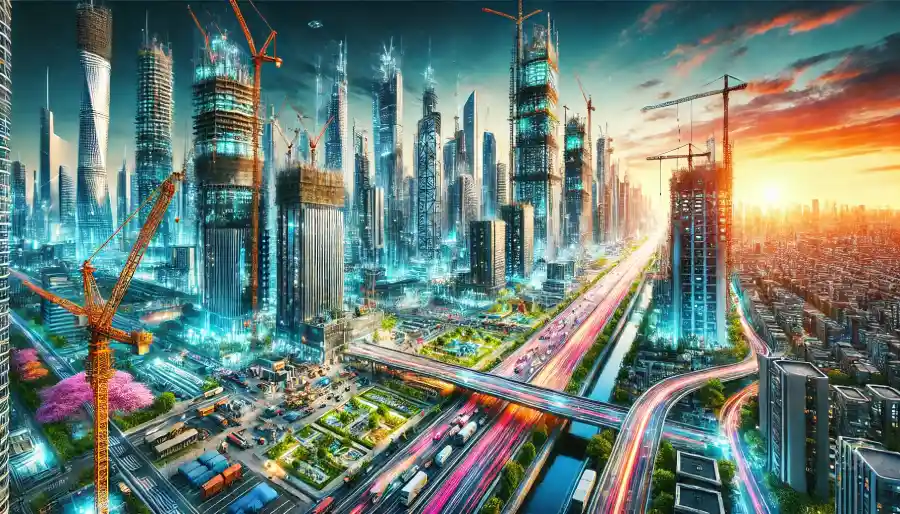How Global Construction Pushes the Boundaries of Urbanization
The skylines of cities worldwide are transforming at an unprecedented pace. Global construction firms are at the forefront of this urban revolution, pushing the boundaries of what’s possible in modern cityscapes. These international construction companies are not just building structures; they’re reshaping the very fabric of urban life. From towering skyscrapers that pierce the clouds to sprawling underground networks that keep cities moving, the impact of global construction on urbanization is profound and far-reaching.
Innovative Architectural Designs Transforming Urban Landscapes
Today’s cities are living canvases for architectural innovation. Global construction firms are bringing to life designs that once existed only in the realms of imagination. Twisted towers, gravity-defying bridges, and buildings that seem to defy physics are now realities in urban centers across the globe.
These avant-garde structures are more than just eye-catching landmarks. They’re functional spaces that serve the evolving needs of urban populations. From mixed-use developments that blend residential, commercial, and recreational areas to adaptive reuse projects that breathe new life into historical buildings, international construction companies are creating versatile urban environments that cater to modern lifestyles.
Sustainable Practices Driving Eco-Friendly Urban Development
As cities grow, so does the need for sustainable development. Global construction firms are leading the charge in implementing eco-friendly practices that minimize environmental impact while maximizing efficiency. Green building techniques, once considered niche, are now standard in many international projects.
From solar panels and wind turbines integrated into building designs to advanced waste management systems and water recycling facilities, these sustainable solutions are becoming integral parts of urban infrastructure. International construction companies are not just building for today; they’re laying the groundwork for resilient, self-sufficient cities of tomorrow. By incorporating these green technologies, they’re helping urban areas reduce their carbon footprint and adapt to the challenges of climate change.
Advanced Technologies Revolutionizing Construction Processes
The construction industry is undergoing a technological renaissance. Cutting-edge tools and techniques are transforming how global construction firms approach projects, from planning to execution. Building Information Modeling (BIM) allows teams to create detailed 3D models of structures before breaking ground, streamlining the design process and reducing costly errors.
On construction sites, robotics and automation are taking on dangerous or repetitive tasks, improving safety and efficiency. Drones survey vast areas and monitor progress from above, while 3D printing technology is being used to create everything from building components to entire houses. These advancements are not just making construction faster and more precise; they’re opening up new possibilities for what can be built and where.
Collaborative Efforts in International Project Management
Building a city takes more than bricks and mortar; it requires seamless coordination among diverse teams spread across the globe. International construction companies excel in bringing together experts from different cultures, time zones, and specialties to work towards a common goal. This global collaboration fosters innovation and ensures that best practices from around the world are incorporated into each project.
Virtual reality and augmented reality tools are bridging geographical gaps, allowing architects in one country to walk through a digital model of a building site on another continent. Cloud-based project management platforms enable real-time communication and decision-making, keeping massive international projects on track. These collaborative technologies are not just tools; they’re catalysts for a new era of global urbanization where ideas and expertise flow freely across borders.
Addressing Infrastructure Challenges in Rapidly Growing Cities
As urban populations swell, cities face mounting pressure on their infrastructure. Global construction firms are at the forefront of tackling these challenges, developing innovative solutions to keep growing cities functional and livable. From expanding public transportation networks to upgrading water and power systems, these companies are building the backbone of modern urban life.
In many rapidly developing regions, international construction companies are not just adding to existing infrastructure; they’re creating it from the ground up. This presents unique opportunities to implement cutting-edge systems without the constraints of legacy infrastructure. Smart city technologies, integrated transportation hubs, and resilient utility networks are being woven into the very fabric of these emerging urban centers, setting new standards for city planning and development worldwide.
The Role of Cultural Influences in Shaping Global Urbanization
While technology and innovation drive much of global construction, cultural considerations play a vital role in shaping urban development. International construction companies must balance modern design principles with local traditions and values. This cultural sensitivity results in urban spaces that are not only functional but also meaningful to the communities they serve.
From incorporating traditional architectural elements into modern skyscrapers to designing public spaces that reflect local customs and social norms, global construction companies are creating cities that honor their cultural roots while embracing the future. This approach to urbanization goes beyond aesthetics; it fosters a sense of belonging and identity in rapidly changing urban environments. As cities become more interconnected, these culturally informed designs serve as bridges between global influences and local heritage, creating truly unique urban landscapes around the world.

